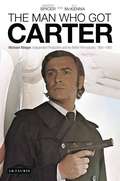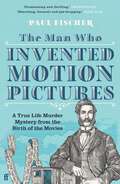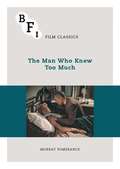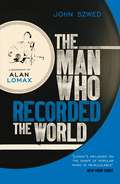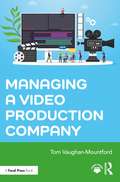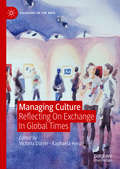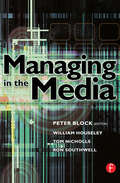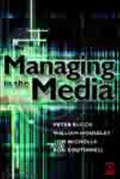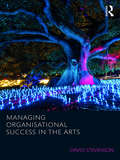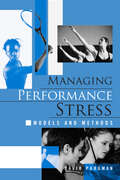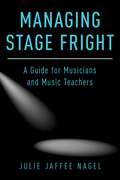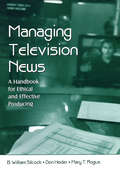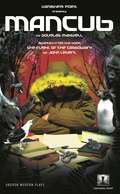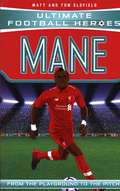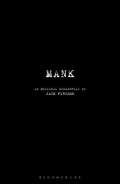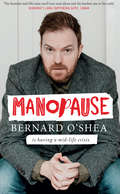- Table View
- List View
The Man Who Got Carter: Michael Klinger, Independent Production and the British Film Industry, 1960-1980 (International Library Of The Moving Image Ser.)
by Andrew Spicer A.T. McKenna A. T. McKennaMichael Klinger was the most successful independent producer in the British film industry over a twenty year period, from 1960 to 1980, responsible for 32 films, including classics such as Repulsion and Get Carter. Despite working with many famous figures, including Michael Caine, Claude Chabrol, Mike Hodges, Lee Marvin and Roman Polanski, Klinger's contribution to British cinema has been ignored.This definitive book on Klinger, largely based on his previously unseen personal papers, examines his origins in the Sixties' Soho sex industry, sexploitation cinema and 'shockumentaries', through to major international productions, including Shout at the Devil. It reveals how Klinger deftly combined commercial product – the popular 'Confessions' series – with artistic, experimental cinema and highlights the importance of his Jewishness. The book also assesses the essential, often misunderstood role played by the producer.
The Man Who Invented Motion Pictures: A True Tale of Obsession, Murder and the Movies
by Paul FischerLouis Le Prince invented the motion picture in 1890. He applied for, and was granted, patents in four countries. And then, a month before unveiling it to the world...he disappeared. And was never seen again.Three years later, Le Prince's invention was finally made public - by a man who claimed to have invented it himself. The man's name was Thomas Edison.This book is the story of the birth of motion pictures, restoring the father of the invention to his rightful place in history.
The Man Who Knew Too Much (BFI Film Classics)
by Murray PomeranceMurray Pomerance offers an illuminating account of one of Hitchcock's most intruiging and successful films, The Man Who Knew Too Much (1956), starring James Stewart and Doris Day. Through a close reading of the film alongside analysis of its complex production history, Pomerance's analysis highlights its darkest nuances, and its themes of musicality, gendered power, and cultural strangeness. He proposes that, far from being a merely charming escapade, the film tells a strange story of doubling, spiritual presence, and the intricacies of social organisation.
The Man Who Recorded the World: A Biography of Alan Lomax
by John SzwedWriter, musicologist, archivist, singer, DJ, filmmaker, record, radio and TV producer, Alan Lomax was a man of many parts. Without him the history of popular music would have been very different. Armed with a tape-recorder and his own near-flawless good taste, Lomax spent years travelling the US, particularly the south, recording its heritage of music and song for posterity, bringing to light the talents of performers ranging from Jelly Roll Morton to Leadbelly and Muddy Waters, and crucially influencing generations of musicians from Pete Seeger to the Stones, from Woody Guthrie to Bob Dylan. His influence continues: recordings made by Lomax are the core of the sound-tracks of Oh Brother, Where art Thou? and Gangs of New York, and even featured, remixed, on Moby's Play. John Szwed's biography is the first ever of this remarkable and contradictory man (whom he both knew and worked with for ten years); through it Szwed will tell the story of a musical and political era, as he did so successfully in his previous book on Miles Davis.
Managing a Video Production Company
by Tom Vaughan-MountfordProviding a detailed break-down of the skills required to establish and grow a profitable production company, this book enables content creators and filmmakers to navigate the commercial video production world and the needs of its clients. Drawing on professional experience in the industry as well historical examples, author Tom Vaughan-Mountford illustrates the ways in which producers can avoid common pitfalls and better manage their business, projects, and clients. Making the corporate world accessible for filmmakers, this book covers all aspects of the video production process, equipping creatives with the tools—and the mindset—to offer their skills to paying clients in a reliable, repeatable, and above all profitable manner. This book is ideal for filmmakers and content creators looking to establish a successful video production business, and features an online resource pack with example production paperwork including a call sheet, and example script re-writes.
Managing a Video Production Company
by Tom Vaughan-MountfordProviding a detailed break-down of the skills required to establish and grow a profitable production company, this book enables content creators and filmmakers to navigate the commercial video production world and the needs of its clients. Drawing on professional experience in the industry as well historical examples, author Tom Vaughan-Mountford illustrates the ways in which producers can avoid common pitfalls and better manage their business, projects, and clients. Making the corporate world accessible for filmmakers, this book covers all aspects of the video production process, equipping creatives with the tools—and the mindset—to offer their skills to paying clients in a reliable, repeatable, and above all profitable manner. This book is ideal for filmmakers and content creators looking to establish a successful video production business, and features an online resource pack with example production paperwork including a call sheet, and example script re-writes.
Managing Culture: Reflecting On Exchange In Global Times (Sociology of the Arts)
by Raphaela Henze Victoria DurrerThis book provides new insights into the relationship of the field of arts and cultural management and cultural rights on a global scale.Globalisation and internationalisation have facilitated new forms for exchange between individuals, professions, groups, localities and nations in arts and cultural management. Such exchanges take place through the devising, programming, exhibition, staging, marketing, and administration of project activities. They also take place through teaching and learning within higher education and cultural institutions, which are now internationalised practices themselves. With a focus on the fine, visual and performing arts, the book positions arts and cultural management educators and practitioners as active agents whose decisions, actions and interactions represent how we, as a society, approach, relate to, and understand ourselves and others. This consideration of education and practice as socialisation processes with global, political and social implications will be an invaluable resource to academics, practitioners and students engaging in arts and cultural management, cultural policy, cultural sociology, global and postcolonial studies.
Managing in the Media
by William Houseley Tom Nicholls Ron Southwell Pamela BlockManaging in the Media has been devised for a broad audience. It is based upon the perceived need for a text that amalgamates cultural theories, film and television analysis, management theories and media production practice into one volume. There are many books on film and cultural studies. Similarly, there are copious numbers of texts written on management. To date little has been written that analyses the management of the audiovisual industry set against the backdrop of the cultural and economic environment within which the media manager operates. Managing in the Media is divided into three sections that take the reader from the global to the specific, from the strategic to the tactical. Each chapter discusses specific topics that can be read in isolation yet contribute to the theme within each part. Taken as a whole, the book provides the potential professional media manager and current practising media manager with a framework of issues that will give them an awareness of the range of knowledge needed by the successful media manager. This book does not try to be a manual to success. The media industry is awash with successful individuals none of whom needed textbooks to set them on their chosen career paths. Yet these exceptional people prove the rule; that in the main, most media practitioners would benefit from some additional support and guidance. The aim of this book is to present to them some of the management issues that have, or will have, an impact upon their working careers. The accompanying website www.mediaops.net (which can also be accessed via www.focalpress.com) features:- Tutor notes and reader activities- Updated list of further reading- Additional support material such as production templates - Interviews with the authors - A discussion forum- Industry and education links- Media News
Managing in the Media
by William Houseley Tom Nicholls Ron Southwell Pamela BlockManaging in the Media has been devised for a broad audience. It is based upon the perceived need for a text that amalgamates cultural theories, film and television analysis, management theories and media production practice into one volume. There are many books on film and cultural studies. Similarly, there are copious numbers of texts written on management. To date little has been written that analyses the management of the audiovisual industry set against the backdrop of the cultural and economic environment within which the media manager operates. Managing in the Media is divided into three sections that take the reader from the global to the specific, from the strategic to the tactical. Each chapter discusses specific topics that can be read in isolation yet contribute to the theme within each part. Taken as a whole, the book provides the potential professional media manager and current practising media manager with a framework of issues that will give them an awareness of the range of knowledge needed by the successful media manager. This book does not try to be a manual to success. The media industry is awash with successful individuals none of whom needed textbooks to set them on their chosen career paths. Yet these exceptional people prove the rule; that in the main, most media practitioners would benefit from some additional support and guidance. The aim of this book is to present to them some of the management issues that have, or will have, an impact upon their working careers. The accompanying website www.mediaops.net (which can also be accessed via www.focalpress.com) features:- Tutor notes and reader activities- Updated list of further reading- Additional support material such as production templates - Interviews with the authors - A discussion forum- Industry and education links- Media News
Managing Organisational Success in the Arts (Routledge Research in Creative and Cultural Industries Management)
by David StevensonThe creative and cultural industries are a dynamic and rapidly expanding field of enterprise. Yet all too often the dominant narrative about arts organisations is one of crisis, collapse, and closure. This edited collection seeks to challenge that narrative through pursuing a focus on organisational success in the management of creative and cultural organisations. This book offers a robust and in-depth analysis of nine international case studies exploring how different organisations have achieved their objectives through effectively managing their resources. Spanning a broad cross section of the cultural sector including Theatres; Multi-Arts Venues; Performing Arts Companies; Museums and Galleries; and Festivals and Events, these cases highlight the importance of examining an individual organisation’s success in relation to its environmental context, revealing not only how arts organisations work in practice, but also providing inspiration and encouragement for those wishing to emulate such success. With an explicit focus on examining theory in practice, this unique collection will be of great interest to students, academics, and practitioners alike. While traditional approaches have often been overly theoretical, this pragmatic approach will help students to gain a richer understanding of how to manage cultural and creative organisations more effectively.
Managing Organisational Success in the Arts (Routledge Research in Creative and Cultural Industries Management)
by David StevensonThe creative and cultural industries are a dynamic and rapidly expanding field of enterprise. Yet all too often the dominant narrative about arts organisations is one of crisis, collapse, and closure. This edited collection seeks to challenge that narrative through pursuing a focus on organisational success in the management of creative and cultural organisations. This book offers a robust and in-depth analysis of nine international case studies exploring how different organisations have achieved their objectives through effectively managing their resources. Spanning a broad cross section of the cultural sector including Theatres; Multi-Arts Venues; Performing Arts Companies; Museums and Galleries; and Festivals and Events, these cases highlight the importance of examining an individual organisation’s success in relation to its environmental context, revealing not only how arts organisations work in practice, but also providing inspiration and encouragement for those wishing to emulate such success. With an explicit focus on examining theory in practice, this unique collection will be of great interest to students, academics, and practitioners alike. While traditional approaches have often been overly theoretical, this pragmatic approach will help students to gain a richer understanding of how to manage cultural and creative organisations more effectively.
Managing Performance Stress: Models and Methods
by David PargmanOver the past 16 years, new theories and models have emerged in the stress and anxiety knowledge base regarding the unique forms associated with performance. Existing theories have been applied in creative and helpful ways to better explicate relationships between stress and anxiety with performance. Recently, more sophisticated statistical strategies have been applied to data collected with performers, and additional, safe and expedient strategies for managing stress and anxiety have surfaced. Despite these new advances, the field has been lacking an up-to-date and practical text for undergraduate and graduate students in performing or performance-mentoring programs. Managing Performance Stress examines psychological and psychophysiological models and theories that explain causes of anxiety and stress. An easy-to-use reference work for athletes, musicians, dancers and actors as well as those who devise and conduct their training programs, the book presents exercises, coaching devices, and strategies for conquering stress and anxiety. It is an invaluable resource for those who are performers, will be performers, or who are preparing to mentor, coach or teach performers. The principles enunciated in Managing Performance Stress apply equally to the musician holding an oboe and the athlete holding a baseball bat. The issues explored and the theories, principles, models, hypotheses discussed all bear upon and clarify arousal, stress and anxiety related to artistic and sport performance, irrespective of its kind.
Managing Performance Stress: Models and Methods
by David PargmanOver the past 16 years, new theories and models have emerged in the stress and anxiety knowledge base regarding the unique forms associated with performance. Existing theories have been applied in creative and helpful ways to better explicate relationships between stress and anxiety with performance. Recently, more sophisticated statistical strategies have been applied to data collected with performers, and additional, safe and expedient strategies for managing stress and anxiety have surfaced. Despite these new advances, the field has been lacking an up-to-date and practical text for undergraduate and graduate students in performing or performance-mentoring programs. Managing Performance Stress examines psychological and psychophysiological models and theories that explain causes of anxiety and stress. An easy-to-use reference work for athletes, musicians, dancers and actors as well as those who devise and conduct their training programs, the book presents exercises, coaching devices, and strategies for conquering stress and anxiety. It is an invaluable resource for those who are performers, will be performers, or who are preparing to mentor, coach or teach performers. The principles enunciated in Managing Performance Stress apply equally to the musician holding an oboe and the athlete holding a baseball bat. The issues explored and the theories, principles, models, hypotheses discussed all bear upon and clarify arousal, stress and anxiety related to artistic and sport performance, irrespective of its kind.
Managing Stage Fright: A Guide for Musicians and Music Teachers
by Julie Jaffee NagelWhy is it that well-prepared, talented, hardworking, and intelligent performers find their performance and self-esteem undermined by the fear of memory slips, technique failures, and public humiliation? In Managing Stage Fright: A Guide for Musicians and Music Teachers, author Julie Jaffee Nagel unravels these mysteries, taking the reader on an intensive backstage tour of the anxious performer's emotions to explain why stage fright happens and what performers can do to increase their comfort in the glare of the spotlight. Examining the topic from her interdisciplinary educational, theoretical, clinical, and personal perspectives, Nagel uses the music teacher/student relationship as a model for understanding the performance anxiety that affects musicians and non-musicians alike. Shedding new light on how the performer's emotional life is connected to every other facet of their life, Managing Stage Fright encourages a deeper understanding of anxiety when performing. The guide offers strategies for achieving performance confidence, emphasizing the relevance of mental health in teaching and performing. Through the practices of self-awareness outlined in the book, Nagel demonstrates that it is possible and desirable for teachers to assist students in developing the coping skills and attitudes that will allow them to not feel overwhelmed and powerless when they experience strong anxiety. Each chapter contains insights that help teachers recognize the symptoms-obvious, subtle, and puzzling-of the emotional grip of stage fright, while offering practical guidelines that empower teachers to empower their students. The psychological concepts offered, when added to pedagogical techniques, are invaluable in music performance and in a variety of life situations since, after all, music lessons are life lessons.
MANAGING STAGE FRIGHT C: A Guide for Musicians and Music Teachers
by Julie Jaffee NagelWhy is it that well-prepared, talented, hardworking, and intelligent performers find their performance and self-esteem undermined by the fear of memory slips, technique failures, and public humiliation? In Managing Stage Fright: A Guide for Musicians and Music Teachers, author Julie Jaffee Nagel unravels these mysteries, taking the reader on an intensive backstage tour of the anxious performer's emotions to explain why stage fright happens and what performers can do to increase their comfort in the glare of the spotlight. Examining the topic from her interdisciplinary educational, theoretical, clinical, and personal perspectives, Nagel uses the music teacher/student relationship as a model for understanding the performance anxiety that affects musicians and non-musicians alike. Shedding new light on how the performer's emotional life is connected to every other facet of their life, Managing Stage Fright encourages a deeper understanding of anxiety when performing. The guide offers strategies for achieving performance confidence, emphasizing the relevance of mental health in teaching and performing. Through the practices of self-awareness outlined in the book, Nagel demonstrates that it is possible and desirable for teachers to assist students in developing the coping skills and attitudes that will allow them to not feel overwhelmed and powerless when they experience strong anxiety. Each chapter contains insights that help teachers recognize the symptoms-obvious, subtle, and puzzling-of the emotional grip of stage fright, while offering practical guidelines that empower teachers to empower their students. The psychological concepts offered, when added to pedagogical techniques, are invaluable in music performance and in a variety of life situations since, after all, music lessons are life lessons.
Managing Television News: A Handbook for Ethical and Effective Producing (Routledge Communication Series)
by B. William Silcock Don Heider Mary T. RogusManaging Television News provides a practical introduction to the television news producer, one of the most significant and influential roles in a newscast. Recognizing the need for formal training in this key role, authors B. William Silcock, Don Heider, and Mary T. Rogus have combined their expertise and experience to shape this essential resource on the responsibilities, demands, and rewards of the news producer position. Their book provides a strategic approach to producing newscasts and serves as an in-depth guide to creating quality, audience-friendly newscasts working within the realistic limitations of most newsrooms. It helps the student and the professional producer sort through the various deadline-driven challenges of creating a 30-minute newscast. Filled with real-world examples and advice from news directors, producers, and anchors currently in the business, and photographs illustrating the varied perspectives in the position, Managing Television News provides critical skill sets to help resolve ethical dilemmas, as well as keen and fresh insights on how to win the ratings without compromising news quality. Career concerns are also addressed. This resource is a pioneering book for the professional television newsroom and the individual reader interested in starting or expanding a producing career. It is an excellent text for the college classroom, as its structure fits neatly into a semester schedule, and it is a must-have resource for both seasoned and novice producers, as well as students in broadcast news.
Managing Television News: A Handbook for Ethical and Effective Producing (Routledge Communication Series)
by B. William Silcock Don Heider Mary T. RogusManaging Television News provides a practical introduction to the television news producer, one of the most significant and influential roles in a newscast. Recognizing the need for formal training in this key role, authors B. William Silcock, Don Heider, and Mary T. Rogus have combined their expertise and experience to shape this essential resource on the responsibilities, demands, and rewards of the news producer position. Their book provides a strategic approach to producing newscasts and serves as an in-depth guide to creating quality, audience-friendly newscasts working within the realistic limitations of most newsrooms. It helps the student and the professional producer sort through the various deadline-driven challenges of creating a 30-minute newscast. Filled with real-world examples and advice from news directors, producers, and anchors currently in the business, and photographs illustrating the varied perspectives in the position, Managing Television News provides critical skill sets to help resolve ethical dilemmas, as well as keen and fresh insights on how to win the ratings without compromising news quality. Career concerns are also addressed. This resource is a pioneering book for the professional television newsroom and the individual reader interested in starting or expanding a producing career. It is an excellent text for the college classroom, as its structure fits neatly into a semester schedule, and it is a must-have resource for both seasoned and novice producers, as well as students in broadcast news.
The Manchurian Candidate (BFI Film Classics)
by Greil Marcus"It may be the most sophisticated political thriller ever made in Hollywood," film critic Pauline Kael wrote of John Frankenheimer's terrifying 1962 political thriller about an American serviceman brainwashed in Korea and made into an assassin. Sophisticated to be sure, it's also a headlong fall through the looking-glass of American politics and the most deeply prophetic film of the second half of the American century. As Greil Marcus reconstructs the drama, The Manchurian Candidate is a movie in which the director and actors, including Laurence Harvey, Frank Sinatra and Angela Lansbury in an Academy Award-nominated performance, were suddenly capable of anything, beyond any expectations. This edition includes a new foreword highlighting the movie's terrifying contemporary relevance in the age of Trump and Russian interference in the US Presidential election.
The Manchurian Candidate (BFI Film Classics)
by Greil Marcus"It may be the most sophisticated political thriller ever made in Hollywood," film critic Pauline Kael wrote of John Frankenheimer's terrifying 1962 political thriller about an American serviceman brainwashed in Korea and made into an assassin. Sophisticated to be sure, it's also a headlong fall through the looking-glass of American politics and the most deeply prophetic film of the second half of the American century. As Greil Marcus reconstructs the drama, The Manchurian Candidate is a movie in which the director and actors, including Laurence Harvey, Frank Sinatra and Angela Lansbury in an Academy Award-nominated performance, were suddenly capable of anything, beyond any expectations. This edition includes a new foreword highlighting the movie's terrifying contemporary relevance in the age of Trump and Russian interference in the US Presidential election.
Mancub (Oberon Modern Plays)
by Douglas MaxwellMancub is the beautiful and absurd story of a boy who seems to be turning into animals. Paul faces the usual struggles of growing up. Struggles for understanding with his father, struggles to work out what girls are about. But he also faces a more pressing problem. Reality seems to be shifting as the people around him begin to display the traits of certain animals.Stranger still are the changes he, and other people, see in himself. Does Paul really turn into animals, or does he only think he does? Mancub is a collaboration between Vanishing Point and acclaimed Scottish writer Douglas Maxwell, whose hits include Decky Does a Bronco and Helmet, both also published by Oberon.
Mane: From the Playground to the Pitch (PDF)
by Matt Oldfield Tom OldfieldSadio Mané is one of Liverpool FC's 'Fab Four'. Along with Mo Salah, Roberto Firmino and Xherdan Shakiri, Sadio's goals have helped make Liverpool the deadliest attacking team in the Premier League. Since he moved to the Premier League, Sadio has been setting the bar to new heights - from scoring the fastest hat-trick in history to becoming the most expensive African footballer ever. There is no stopping the Fab Four, and the sky is the limit for Sadio Mané. Ultimate Football Heroes is a series of biographies telling the life stories of the biggest and best footballers in the world and their incredible journeys from childhood fan to superstar professional player. Written in fast-paced, action-packed style these books are perfect for all the family to collect and share.
Manga and Anime Go to Hollywood
by Northrop DavisThe media industries in the United States and Japan are similar in much the same way different animal species are: while a horse and a kangaroo share maybe 95% of their DNA, they're nonetheless very different animals-and so it is with manga and anime in Japanese and Hollywood animation, movies, and television. Though they share some key common elements, they developed mostly separately while still influencing each other significantly along the way. That confluence is now accelerating into new forms of hybridization that will drive much of future storytelling entertainment. Packed with original interviews with top creators in these fields and illuminating case studies, Manga and Anime Go to Hollywood helps to parse out these shared and diverging genetic codes, revealing the cross-influences and independent traits of Japanese and American animation.In addition, Manga and Anime Go to Hollywood shows how to use this knowledge creatively to shape the future of global narrative storytelling, including through the educational system. Northrop Davis paints a fascinating picture of the interrelated history of Japanese manga/anime and Hollywood since the Meiji period through to World War II and up to the present day - and even to into the future.
Mank: An Original Screenplay
by Jack FincherDavid Fincher's Mank recreates 1930s Hollywood through the eyes of scathing wit and alcoholic screenwriter Herman J. Mankiewicz as he races to finish Citizen Kane. Starring Gary Oldman as Mankiewicz, Amanda Seyfried as Marion Davies, Charles Dance as William Randolph Hearst and Tom Burke as Orson Welles.
Mank: An Original Screenplay
by Jack FincherDavid Fincher's Mank recreates 1930s Hollywood through the eyes of scathing wit and alcoholic screenwriter Herman J. Mankiewicz as he races to finish Citizen Kane. Starring Gary Oldman as Mankiewicz, Amanda Seyfried as Marion Davies, Charles Dance as William Randolph Hearst and Tom Burke as Orson Welles.
Manopause: Bernard O’Shea is having a mid-life crisis
by Bernard O'SheaHaving just turned 40, Bernard O’Shea found himself hurtling towards a mid-life crisis.His waistline expanded, his flexibility abandoned him, his wardrobe was invaded by elasticated beige trousers and sandals – what on earth was going on?In his hilarious and often alarmingly honest style, Bernard documents his journey, first fighting it tooth and nail – buying into every fad diet and hair-growth pill, even returning to Mass to find faith – before recruiting the help of a therapist, some experts in mindfulness, and, as always, the support of his longsuffering wife. Can Bernard navigate this time of his life to come out the other side with his dignity intact? He’s about to find out …
